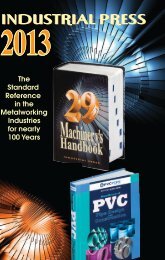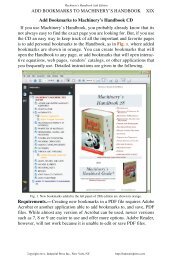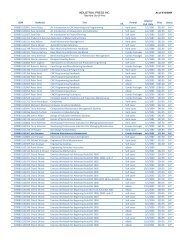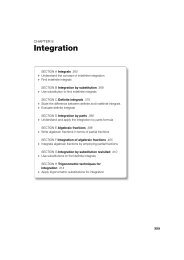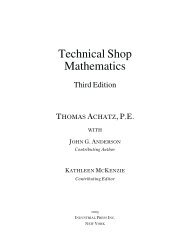computer numerical control programming basics - Industrial Press
computer numerical control programming basics - Industrial Press
computer numerical control programming basics - Industrial Press
Create successful ePaper yourself
Turn your PDF publications into a flip-book with our unique Google optimized e-Paper software.
Code Function<br />
M00 Program stop<br />
M02 End of program<br />
M03 Spindle start (forward CW)<br />
M04 Spindle start (reverse CCW)<br />
M05 Spindle stop<br />
M06 Tool change<br />
M08 Coolant on<br />
M09 Coolant off<br />
M10 Chuck - clamping (**)<br />
M11 Chuck - unclamping (**)<br />
M12 Tailstock spindle out (**)<br />
M13 Tailstock spindle in (**)<br />
M17 Toolpost rotation normal (**)<br />
M18 Toolpost rotation reverse (**)<br />
M30 End of tape and rewind<br />
M98 Transfer to subprogram<br />
M99 End of subprogram<br />
(**) - refers only to CNC lathes and turning centers.<br />
Fig. 16 Some of the most common M-codes used in CNC <strong>programming</strong>.<br />
Block of Information<br />
CNC information is generally programmed in blocks of five words.<br />
Each word conforms to the EIA standards and they are written on<br />
a horizontal line. If five complete words are not included in each<br />
block, the machine <strong>control</strong> unit (MCU) will not recognize the<br />
information, therefore the <strong>control</strong> unit will not be activated.<br />
Using the example shown in Fig. 17 , the five words are as follows:<br />
N001 represents the sequence number of the operation.<br />
G01 represents linear interpolation<br />
X12345 will move the table 1.2345 in. in a positive direction<br />
along the X axis.<br />
Y06789 will move the table 0.6789 in. along the Y axis.<br />
M03 Spindle on CW.<br />
22



